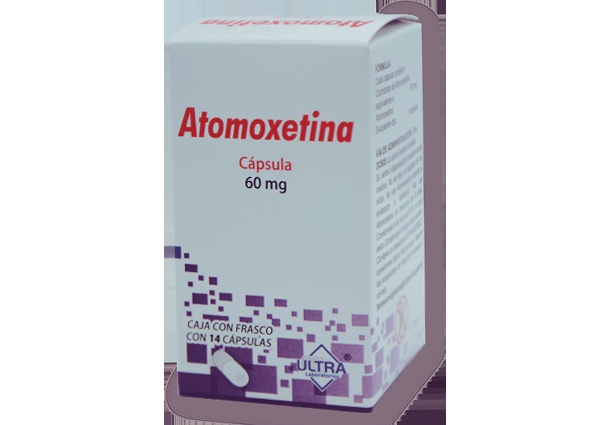

ATOMOXETINA CINFA 60 mg CÁPSULAS DURAS

Pergunte a um médico sobre a prescrição de ATOMOXETINA CINFA 60 mg CÁPSULAS DURAS

Como usar ATOMOXETINA CINFA 60 mg CÁPSULAS DURAS
Introdução
Prospecto: informação para o utilizador
atomoxetina cinfa 60 mg cápsulas duras EFG
atomoxetina hidrocloruro
Leia todo o prospecto detenidamente antes de começar a tomar este medicamento, porque contém informações importantes para si.
- Conserva este prospecto, porque pode ter que voltar a lê-lo. Se tiver alguma dúvida, consulte o seu médico ou farmacêutico.
- Este medicamento foi-lhe prescrito somente a si ou ao seu filho, e não deve dá-lo a outras pessoas, embora tenham os mesmos sintomas que si, porque pode prejudicá-las.
- Se experimentar efeitos adversos, consulte o seu médico ou farmacêutico, mesmo que se trate de efeitos adversos que não aparecem neste prospecto. Ver secção 4.
Conteúdo do prospecto
- O que é atomoxetina cinfa e para que é utilizado
- O que necessita saber antes de começar a tomar atomoxetina cinfa
- Como tomar atomoxetina cinfa
- Posíveis efeitos adversos
- Conservação de atomoxetina cinfa
- Conteúdo do envase e informação adicional
1. O que é atomoxetina cinfa e para que é utilizado
Para que é utilizado
atomoxetina cinfa contém atomoxetina e é utilizado no tratamento do transtorno por déficit de atenção com hiperactividade (TDAH). É utilizado:
- em crianças a partir dos 6 anos
- em jovens
- em adultos
É utilizado apenas como parte do tratamento completo da doença que requer também tratamentos que não incluem medicamentos, como aconselhamento ou terapia de conduta.
Não é utilizado para o tratamento do TDAH em crianças menores de 6 anos devido a que não se conhece se o fármaco funciona ou se é seguro nesta população.
Em adultos, atomoxetina cinfa é utilizado para o tratamento do TDAH quando os sintomas são muito problemáticos e afetam o trabalho ou a vida social e quando teve sintomas da doença quando era criança.
Como funciona
atomoxetina cinfa aumenta a quantidade de noradrenalina no cérebro. Esta é uma substância química produzida de forma natural e que aumenta a atenção e diminui a impulsividade e hiperactividade nos pacientes com TDAH. Este medicamento foi-lhe prescrito para ajudar a controlar os sintomas do TDAH. Este medicamento não é um estimulante e, portanto, não provoca dependência.
Podem tardar algumas semanas desde que comece o tratamento com o medicamento até que os sintomas melhorem completamente.
Sobre o TDAH
Crianças e jovens com TDAH encontram:
- dificuldade em estar sentados
- dificuldade em concentrar-se
Não é culpa sua que não possam fazer estas coisas. A muitas crianças e jovens isto é difícil. No entanto, aos pacientes com TDAH isto pode causar problemas no dia a dia.
Crianças e jovens com TDAH podem ter dificuldade em aprender e fazer os deveres. Têm dificuldade em se comportar bem em casa, na escola ou em outros lugares. O TDAH não afeta a inteligência de uma criança ou de um jovem.
Adultos com TDAH encontram difícil fazer todas as coisas que as crianças também encontram difíceis, no entanto isto pode significar que tenham problemas com:
- trabalho
- relações
- baixa autoestima
- educação.
2. O que necessita saber antes de começar a tomar atomoxetina cinfa
Não tome atomoxetina cinfa:
- se é alérgico à atomoxetina ou a algum dos outros componentes deste medicamento (incluídos na secção 6).
- se tomou nas últimas duas semanas um medicamento dos denominados inibidores da monoaminooxidase (IMAO), por exemplo fenelzina. Os IMAO são utilizados às vezes para a depressão e outros transtornos mentais; tomar atomoxetina juntamente com um IMAO poderia causar efeitos adversos graves ou constituir uma ameaça para a vida. Assim como deve esperar pelo menos 14 dias após terminar o tratamento com atomoxetina antes de tomar um IMAO.
- se tem uma doença ocular chamada glaucoma de ângulo estreito (aumento da pressão nos olhos).
- se tem problemas graves de coração que podem piorar com um aumento na frequência cardíaca e/ou na pressão sanguínea, o que pode ocorrer com atomoxetina.
- se tem problemas graves nos vasos sanguíneos do seu cérebro, tais como um derrame cerebral, parte de um vaso sanguíneo inflamado e debilitado (aneurisma) ou vasos sanguíneos estreitos ou obstruídos.
- se tem um tumor da sua glândula adrenal (feocromocitoma).
Não tome atomoxetina se lhe aplicar algum dos casos anteriores. Se não estiver seguro, consulte o seu médico ou farmacêutico antes de tomar atomoxetina devido a que atomoxetina pode piorar estes problemas.
Advertências e precauções
Tanto os adultos como as crianças devem ter em conta as seguintes advertências e precauções.
Consulte o seu médico ou farmacêutico antes de começar a tomar atomoxetina se tem:
- ideias ou tentativa de suicídio.
- problemas cardíacos (incluídos defeitos cardíacos) ou uma frequência cardíaca aumentada. Atomoxetina pode aumentar a sua frequência cardíaca (pulso). Foram notificados casos de morte súbita em pacientes com defeitos cardíacos.
- a pressão sanguínea elevada. Atomoxetina pode aumentar a sua pressão sanguínea
- a pressão sanguínea baixa. Atomoxetina pode causar tonturas ou desmaios em pessoas que tenham a pressão sanguínea baixa.
- problemas com mudanças repentinas na sua pressão sanguínea ou frequência cardíaca.
- doença cardiovascular ou antecedentes de ter sofrido um acidente cerebrovascular.
- problemas de fígado. Pode necessitar de uma dose menor.
- reações psicóticas, incluindo alucinações (ouvir vozes ou ver coisas irreais), acreditar em coisas que não são verdadeiras ou mostrar-se desconfiado.
- mania (sentir-se exaltado ou sobre-excitado, o que provoca um comportamento incomum) e agitação.
- sentimento agressivo.
- sentimento de antipatia e raiva (hostilidade).
- antecedentes de epilepsia ou tenha sofrido convulsões por alguma outra razão. Atomoxetina poderia produzir um aumento na frequência das convulsões.
- estado de ânimo diferente do habitual (mudanças de humor) ou sentimento de infelicidade.
- espasmos repetidos de difícil controle de qualquer parte do corpo ou repetição de sons e palavras.
O tratamento com atomoxetina pode fazer com que se sinta agressivo, hostil ou violento; ou agravar estes sintomas se estavam presentes antes do tratamento. Também pode causar mudanças incomuns no seu comportamento ou estado de ânimo (incluindo agressão física, comportamento ameaçador e pensamentos de prejudicar outros). Se si ou a sua família e/ou amigos notam alguma destas reações, fale com o seu médico ou farmacêutico imediatamente.
Consulte com o seu médico ou farmacêutico se tem algum dos sintomas mencionados anteriormente antes de começar o tratamento, devido a que atomoxetina pode fazer com que estes problemas piorem. O seu médico quererá fazer um acompanhamento sobre como o medicamento o afeta.
Síndrome serotoninérgico
O síndrome serotoninérgico é uma situação que ameaça potencialmente a vida que pode aparecer quando se toma atomoxetina em combinação com outros medicamentos (ver secção 2 “Toma de atomoxetina cinfa com outros medicamentos”). Os sinais e sintomas do síndrome serotoninérgico podem incluir uma combinação dos seguintes: confusão, inquietude, falta de coordenação e rigidez, alucinações, coma, batimentos cardíacos rápidos, aumento da temperatura corporal, mudanças rápidas na pressão arterial, suor, rubor, tremores, reflexos hiperativos, náuseas, vómitos e diarreia. Entre em contato com um médico ou vá imediatamente ao serviço de urgências do hospital mais próximo se acredita que está sofrendo do síndrome serotoninérgico.
Exames que o seu médico realizará antes de começar a tomar atomoxetina cinfa
Estes exames são para decidir se atomoxetina é o medicamento correto para si.
O seu médico medirá a sua:
- pressão sanguínea e a sua frequência cardíaca (pulso) antes e durante o tempo que estiver tomando atomoxetina
- peso e a sua altura se durante o tempo em que estiver tomando atomoxetina cinfa, si for uma criança ou um adolescente.
O seu médico perguntará sobre:
- outros medicamentos que está tomando
- se tem antecedentes familiares de morte súbita
- qualquer outro problema médico (tais como problemas cardíacos) que si ou a sua família possam ter.
É importante que forneça toda a informação que puder. Isto ajudará o seu médico a decidir se atomoxetina é o medicamento correto para si. O seu médico pode decidir fazer outros exames médicos antes de começar o tratamento com este medicamento.
Toma de atomoxetina cinfa com outros medicamentos
Informa o seu médico ou farmacêutico se está tomando, tomou recentemente ou poderia ter que tomar qualquer outro medicamento.
O seu médico decidirá se pode tomar atomoxetina com outros medicamentos e, em alguns casos, pode que o seu médico necessite ajustar a dose ou aumentá-la mais lentamente.
Não tome atomoxetina com os medicamentos chamados IMAO (inibidores da monoaminooxidase) tomados para a depressão. Ver secção 2 “Não tome atomoxetina cinfa”.
Atomoxetina pode afetar ou ser afetada por outros medicamentos. Estes incluem:
- alguns antidepressivos, opioides como tramadol e medicamentos utilizados para tratar a enxaqueca chamados triptanes. Estes medicamentos podem interagir com atomoxetina e provocar o síndrome serotoninérgico, uma situação que ameaça potencialmente a vida. (Ver secção 2, Advertências e precauções, Síndrome serotoninérgico).
Se está tomando outros medicamentos, atomoxetina pode afetar o funcionamento correto destes ou provocar efeitos adversos. Se si está tomando algum dos seguintes medicamentos, verifique com o seu médico ou farmacêutico antes de tomar atomoxetina:
- medicamentos que aumentam a pressão sanguínea ou são utilizados para controlá-la.
- medicamentos tais como antidepressivos, por exemplo imipramina, venlafaxina mirtazapina, fluoxetina e paroxetina.
- alguns remédios para a tos e o resfriado que contenham medicinas que podem afetar a pressão sanguínea. Quando comprar este tipo de produtos, é importante verificar com o seu farmacêutico.
- alguns medicamentos utilizados para tratar transtornos mentais.
- medicamentos que se sabe que aumentam o risco de convulsões.
- alguns medicamentos que fazem com que atomoxetina permaneça no corpo mais tempo do que o normal (tais como quinidina e terbinafina).
- salbutamol (um medicamento para o tratamento da asma) quando tomado por via oral ou injetado, pode ter a sensação de que o seu coração se acelera, mas isto não piorará a sua asma.
Os medicamentos descritos abaixo podem aumentar o risco de apresentar um ritmo cardíaco anormal quando se está tomando atomoxetina:
- medicamentos utilizados para controlar o ritmo cardíaco
- medicamentos que alteram o conteúdo de sais do sangue
- medicamentos para a prevenção e o tratamento da malária
- antibióticos (como eritromicina e moxifloxacino).
Se não estiver seguro sobre se os medicamentos que está tomando estão na lista de medicamentos comentada anteriormente, consulte com o seu médico ou farmacêutico antes de tomar atomoxetina.
Gravidez e lactação
Não se sabe se este medicamento pode afetar o feto ou pode passar para o leite materno.
- Este medicamento não deve ser tomado durante a gravidez a não ser que o seu médico lhe indique o contrário.
- Deve evitar tomar este medicamento se está amamentando ou deixar de amamentar.
Se está grávida ou em período de lactação, acredita que possa estar grávida ou tem intenção de ficar grávida, consulte o seu médico ou farmacêutico antes de utilizar este medicamento.
Condução e uso de máquinas
atomoxetina cinfa pode produzir cansaço ou sonolência. Tenha cuidado se conduz ou utiliza maquinaria pesada até que saiba como lhe afeta a tomada de atomoxetina cinfa. Se se sentir cansado ou com sonolência não deve conduzir ou utilizar maquinaria pesada.
Informação importante sobre alguns dos componentes de atomoxetina cinfa
Não abra as cápsulas de atomoxetina porque o conteúdo pode irritar os olhos. Se o conteúdo das cápsulas entrar em contato com os olhos, enxágue-os imediatamente com água abundante e consulte o seu médico. Se as mãos ou qualquer outra parte do corpo entrarem em contato com o conteúdo da cápsula, deve enxaguar com água o mais rapidamente possível.
atomoxetina cinfa contém sódio
Este medicamento contém menos de 23 mg de sódio (1mmol) por cápsula; isto é, essencialmente “isento de sódio”.
3. Como tomar atomoxetina cinfa
- Siga exatamente as instruções de administração deste medicamento indicadas pelo seu médico ou farmacêutico. Em caso de dúvida, consulte novamente o seu médico ou farmacêutico. Isto será normalmente uma ou duas vezes ao dia (manhã e última hora da tarde ou primeira da noite).
- As crianças não devem tomar este medicamento sem a ajuda de um adulto.
- Se sentir sonolência ou náuseas quando está tomando atomoxetina uma vez ao dia, o seu médico pode mudar a tomada de medicamento para duas vezes ao dia.
- As cápsulas devem ser engolidas inteiras com ou sem alimentos.
- As cápsulas não devem ser abertas e o conteúdo do interior das cápsulas não deve ser removido de nenhuma outra forma. O tomar o medicamento sempre à mesma hora cada dia pode ajudar a lembrar que deve tomá-lo.
Quanto tomar
Se é uma criança (a partir dos 6 anos) ou um adolescente:
O seu médico indicará a dose de atomoxetina que deve tomar com base no seu peso. Normalmente deve começar com uma dose baixa antes de aumentá-la, com base no seu peso.
- Até 70 kg de peso: Começando com uma dose diária total de 0,5 mg por kg de peso durante um mínimo de 7 dias. O seu médico decidirá então se aumenta para a dose habitual de manutenção de 1,2 mg por kg de peso e por dia.
- Mais de 70 kg de peso: Começando com uma dose diária total de atomoxetina de 40 mg durante um mínimo de 7 dias. O seu médico decidirá então se aumenta para a dose habitual de manutenção de 80 mg ao dia. A dose máxima diária é de 100 mg.
Adultos
- Deve começar atomoxetina com uma dose diária total de 40 mg durante um mínimo de 7 dias. O seu médico decidirá então se aumenta para a dose habitual de manutenção de 80 mg a 100 mg ao dia. A dose máxima diária é de 100 mg.
Se tiver problemas de fígado, o seu médico pode recomendar uma dose menor.
Se tomar mais atomoxetina cinfa do que deve
Em caso de sobredose ou ingestão acidental, consulte imediatamente o seu médico ou farmacêutico ou ligue para o Serviço de Informação Toxicológica, telefone: 91 562 04 20, indicando o medicamento e a quantidade ingerida.
Os sintomas mais comumente comunicados após uma sobredose são sintomas gastrointestinais, sonolência, tonturas, tremores e comportamento anormal. Muito raramente, também foi notificado o síndrome serotoninérgico, uma situação que ameaça potencialmente a vida. (Ver secção 2, Advertências e precauções, Síndrome serotoninérgico).
Se esquecer de tomar atomoxetina cinfa
Se esquecer de uma dose, tome outra o mais rápido possível, mas não tome uma quantidade que ultrapasse a dose diária total em um período de 24 horas. Não tome uma dose dupla para compensar as doses esquecidas.
Se interromper o tratamento com atomoxetina cinfa
Se deixar de tomar atomoxetina, normalmente não aparecem efeitos adversos, mas os sintomas do TDAH podem reaparecer. Deve falar com o seu médico antes de interromper o tratamento.
O que fará o seu médico quando estiver em tratamento: O seu médico fará alguns exames
- Antes de começar, assegurará que atomoxetina é seguro e beneficiará a si.
- Depois de começar, os exames serão feitos pelo menos a cada 6 meses, embora possam ser mais frequentes.
Os exames também serão realizados quando a dose for modificada. Estes exames incluirão:
- Medição da altura e do peso em crianças e jovens.
- Medição da pressão sanguínea e da frequência cardíaca.
- Verificar se tem algum problema ou se os efeitos adversos pioraram enquanto está tomando atomoxetina.
Tratamento a longo prazo
Atomoxetina não precisa ser tomada indefinidamente. Se tomar atomoxetina cinfa durante mais de um ano, o seu médico deve rever o tratamento para verificar se o medicamento ainda é necessário.
Se tiver alguma outra dúvida sobre o uso deste medicamento, pergunte ao seu médico ou farmacêutico.
4. Efeitos adversos possíveis
Tal como todos os medicamentos, este medicamento pode produzir efeitos adversos, embora nem todas as pessoas os sofram. Embora algumas pessoas sofram efeitos adversos, a maioria considera que a atomoxetina ajuda. O seu médico falar-lhe-á sobre estes efeitos adversos.
Alguns efeitos adversos poderiam ser graves. Se apresentar algum dos efeitos descritos abaixo, entre imediatamente em contacto com o seu médico.
Pouco frequentes(podem afetar até 1 em cada 100 pessoas)
- sente ou tem um ritmo cardíaco muito rápido, ritmo cardíaco anormal
- pensamento ou sentimento de suicídio
- sentimento agressivo
- sentimento de antipatia e de enfado (hostilidade)
- mudanças de humor
- reação alérgica grave com sintoma de:
- inchação da face e garganta
- dificuldade para respirar
- urticária (pequenas ronchas vermelhas e com picor na pele)
- convulsões
- sintomas psicóticos incluindo alucinações (tais como ouvir vozes ou ver coisas que não existem), acreditar coisas que não são verdadeiras ou mostrar-se desconfiado.
Crianças e jovens menores de 18 anos têm maior risco de sofrer efeitos adversos tais como:
- pensamento ou sentimento de suicídio (podem afetar até 1 em cada 100 pessoas)
- mudanças de humor (podem afetar até 1 em cada 10 pessoas).
Os adultos têm um risco menor(podem afetar até 1 em cada 1.000 pessoas) de sofrer efeitos adversos tais como:
- convulsões
- sintomas psicóticos incluindo alucinações (tais como ouvir vozes ou ver coisas que não existem), acreditar coisas que não são verdadeiras ou mostrar-se desconfiado.
Raros(podem afetar até 1 em cada 1.000 pessoas)
- afetação do fígado.
Interrompa o tratamento com atomoxetina e entre imediatamente em contacto com o seu médico se aparecer algum dos efeitos adversos seguintes:
- urina escura
- pele e olhos amarelados
- dor ao palpar na parte superior direita do abdômen, justo abaixo das costelas
- sensação de malestar (náuseas) sem explicação
- cansaço
- picor
- sensação de começar com um resfriado.
Outros efeitos adversos notificados foram os seguintes. Se algum deles piorar, consulte com o seu médico ou farmacêutico.
Efeitos adversos muito frequentes(podem afetar mais de 1 em cada 10 pessoas) | |
CRANÇAS maiores de 6 anos e JOVENS | ADULTOS |
Estes efeitos podem desaparecer passado um tempo na maioria dos pacientes |
|
Efeitos adversos frequentes(podem afetar até 1 em cada 10 pessoas) | |
CRANÇAS maiores de 6 anos e JOVENS | ADULTOS |
|
|
Efeitos adversos pouco frequentes(podem afetar até 1 em cada 100 pessoas) | ||
CRANÇAS maiores de 6 anos e JOVENS | ADULTOS | |
|
| |
Efeitos adversos raros(podem afetar até 1 em cada 1.000 pessoas) | ||
CRANÇAS maiores de 6 anos e JOVENS | ADULTOS | |
|
| |
Efeitos adversos de frequência nãoconhecida (não pode ser estimada a partir dos dados disponíveis) | ||
CRANÇAS maiores de 6 anos e JOVENS | ||
|
Efeitos sobre o crescimento
Quando algumas crianças começam a tomar atomoxetina, o seu crescimento (peso e altura) é diminuído. No entanto, com um tratamento a longo prazo, as crianças recuperam o peso e a altura adequados à sua faixa etária. O seu médico vigiará a altura e o peso do seu filho. Se o seu filho não crescer ou ganhar peso como se espera, o seu médico pode alterar a dose de atomoxetina ou suspender temporariamente o tratamento com atomoxetina.
Comunicação de efeitos adversos
Se experimentar qualquer tipo de efeito adverso, consulte o seu médico ou farmacêutico, mesmo que se trate de possíveis efeitos adversos que não aparecem neste prospecto. Também pode comunicá-los diretamente através do Sistema Espanhol de Farmacovigilância de Medicamentos de Uso Humano: https://www.notificaram.es. Mediante a comunicação de efeitos adversos, você pode contribuir para fornecer mais informações sobre a segurança deste medicamento.
5. Conservação de atomoxetina cinfa
Mantenha este medicamento fora da vista e do alcance das crianças.
Não utilize este medicamento após a data de validade que aparece no envase e no blister após “CAD”. A data de validade é o último dia do mês que se indica.
Este medicamento não requer condições especiais de conservação.
Os medicamentos não devem ser jogados nos esgotos nem na lixeira. Deposite os envases e os medicamentos que não precisa no Ponto SIGRE da farmácia. Em caso de dúvida, pergunte ao seu farmacêutico como se livrar dos envases e dos medicamentos que não precisa. Dessa forma, você ajudará a proteger o meio ambiente.
6. Conteúdo do envase e informação adicional
Composição deatomoxetina cinfa
- O princípio ativo é hidrocloruro de atomoxetina. Cada cápsula dura contém 60 mg de atomoxetina (como hidrocloruro).
- Os componentes do conteúdo da cápsula são: amido de milho pregelatinizado, dimeticona, sílica coloidal anidra.
- A composição da cobertura da cápsula é: gelatina, laurilsulfato de sódio (E487), dióxido de titânio (E 171), óxido de ferro amarelo (E172), índigo carmim (E132), água purificada e tinta preta (ShellacGlaze-45% em etanol, óxido de ferro preto e propilenglicol).
Aspecto do produto e conteúdo do envase
Cápsula dura, com uma tampa de cor azul opaco e um corpo amarelo e tem impressa em tinta preta a legenda “60” e “mg”.
atomoxetina cinfa 60 mg cápsulas duras EFG está disponível em envases de 7, 14, 28 e 56 cápsulas.
Pode ser que apenas alguns tamanhos de envases estejam comercializados.
Titular da autorização de comercialização e responsável pela fabricação
Titular da autorização de comercialização:
Laboratórios Cinfa, S.A.
Carretera Olaz-Chipi, 10. Polígono Industrial Areta
31620 Huarte (Navarra) - Espanha
Responsável pela fabricação:
Pharmathen, S.A.
Dervenakion 6
Pallini Attiki 15351
Grécia
Ou
Pharmathen International, S.A.
Industrial Park Sapes Rodopi Perfecture
Block No. 5
Rodopy 69300
Grécia
Ou
Laboratórios Cinfa, S.A.
Carretera Olaz-Chipi, 10. Polígono Industrial Areta
31620 Huarte (Navarra) - Espanha
Data da última revisão deste prospecto:Novembro 2024
A informação detalhada deste medicamento está disponível na página web da Agência Espanhola de Medicamentos e Produtos Sanitários (AEMPS) http://www.aemps.gob.es/
Você pode acessar informação detalhada e atualizada sobre este medicamento escaneando com o seu telefone móvel (smartphone) o código QR incluído no prospecto e cartonagem. Também pode acessar esta informação no seguinte endereço de internet: https://cima.aemps.es/cima/dochtml/p/82445/P_82445.html
Código QR a: https://cima.aemps.es/cima/dochtml/p/82445/P_82445.html

Quanto custa o ATOMOXETINA CINFA 60 mg CÁPSULAS DURAS em Espanha em 2025?
O preço médio do ATOMOXETINA CINFA 60 mg CÁPSULAS DURAS em novembro de 2025 é de cerca de 43.69 EUR. Os valores podem variar consoante a região, a farmácia e a necessidade de receita. Confirme sempre com uma farmácia local ou fonte online para obter informações atualizadas.
- País de registo
- Preço médio em farmácia43.69 EUR
- Disponibilidade em farmáciasProblema de disponibilidade reportado
- Substância ativa
- Requer receita médicaSim
- Fabricante
- Esta informação é apenas para referência e não constitui aconselhamento médico. Consulte sempre um médico antes de tomar qualquer medicamento. A Oladoctor não se responsabiliza por decisões médicas baseadas neste conteúdo.
- Alternativas a ATOMOXETINA CINFA 60 mg CÁPSULAS DURASForma farmacêutica: CÁPSULA, 10 mgSubstância ativa: atomoxetineFabricante: Laboratorios Rubio S.A.Requer receita médicaForma farmacêutica: CÁPSULA, 100 mgSubstância ativa: atomoxetineFabricante: Laboratorios Rubio S.A.Requer receita médicaForma farmacêutica: CÁPSULA, 18 mgSubstância ativa: atomoxetineFabricante: Laboratorios Rubio S.A.Requer receita médica
Alternativas a ATOMOXETINA CINFA 60 mg CÁPSULAS DURAS noutros países
As melhores alternativas com o mesmo princípio ativo e efeito terapêutico.
Alternativa a ATOMOXETINA CINFA 60 mg CÁPSULAS DURAS em Polónia
Alternativa a ATOMOXETINA CINFA 60 mg CÁPSULAS DURAS em Ukraine
Médicos online para ATOMOXETINA CINFA 60 mg CÁPSULAS DURAS
Avaliação de posologia, efeitos secundários, interações, contraindicações e renovação da receita de ATOMOXETINA CINFA 60 mg CÁPSULAS DURAS – sujeita a avaliação médica e regras locais.













